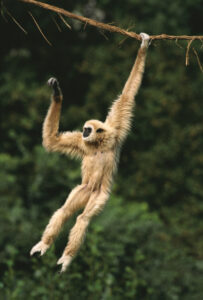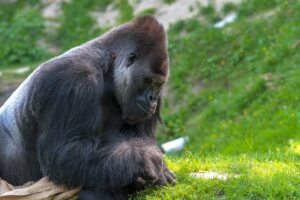
Primates are an order of mammals which consists of apes, lemurs, lorises, galagos, monkeys, and pottos. Even Human Beings(Homo sapiens) are scientifically classified as a Primate.
Many Primates have tails; except apes do not have tails and apes are also usually larger than other Primates. Apes also have wider chests. However some Primate species such as the Bald Uakari (Cacajao calvus) have a tail so short it is hardly visible. Many species of new world monkeys have prehensile tails; this means they can use their tails for grasping and hanging from tree branches.
Range
Primates can be found in Africa, Asia, and Latin America. There are new world monkeys; these are the monkeys that live in the Americas and the old world monkeys; these are the monkeys that live in Africa and Asia. There is an introduced population of Barbary Macaques (Macaca sylvanus) in Gibraltar; this makes them the only free-living Primate besides Human Beings which live in Europe. The Barbary Macaque also lives in the African countries of Algeria, Tunisia, and Morocco.
Locomotion
Primates typically walk on all four limbs but some species can walk upright for short spurts; however Human Beings always walk upright. Some prosimians move by hopping in an almost upright stance.

There are quite a few Primates that are adept at climbing and maneuvering through trees. Some species use a form of arboreal locomotion known as brachiation, or simply arm swinging; this is when the Primate swings from branch to branch using only its arms. Gibbons are Primates that often use brachiation.
Habitat
Primate habitat includes; rainforest, tropical forest, coastal forest, montane forest, lowland forests, savannah, highland meadows, swamps, bushes, spiny forest, urban areas, and farmland.
Diet
What a Primate eats varies from one species to another but some of the things one may eat are; bark, berries, flowers, fruit, fungi, insects, leaves, lichens, nectar, plants, seeds, shoots, small vertebrates, and spiders. The tarsiers are the only fully carnivorous Primate family. Tarsiers mostly eat insects but will also occasionally eat; frogs, lizards, and crabs.
Suborders And Families
Primates are divided into two suborders; Strepsirrhini, which consists of lemurs, galagos and lorisids. The second suborder; Haplorhini, consists of tarsiers, and monkeys and apes.
Strepsirrhini
The Primates classified in Strepsirrhini are often called Strepsirrhines, or prosimians. The tip of a Strepsirrhine’s snout is moist. Their eyes contain a reflective layer known as a tapetum lucidum to improve their night vision. A further classification of Strepsirrhines is listed below:
- Order: Primates
- Suborder: Strepsirrhini
- Family Cheirogaleidae. Cheirodaleidae consists of dwarf and mouse lemurs; 42 species divided into 5 genera. The dwarf and mouse lemurs are all found on the African island nation Madagascar. Dwarf and mouse lemurs are arboreal and nocturnal. Cheirogalids are great tree climbers and can jump far.
- Family Daubentoniidae. Daubentoniidae consists of only 1 species; the Aye-Aye (Daubentonia madagascariensis). The Aye-Aye only lives in Madagascar. The average measurements of an Aye-Aye are; are 40 centimeters(1’4”) long and an average body weight of 2 kilograms(4.4 pounds).
- Family Galagidae. Galagidae consists of galagos, also known as bush babies, or nagapies. All galagos live in Africa. There are 23 species divided into 6 genera.
- Family Indriidae. Indriidae consists of the Indri(Indri indri), wooly lemurs, and sifakas. There are 19 species divided into 3 genera.
- Family Lemuridae. Lemuridae consists of the Ring-Tailed Lemur(Lemur catta) and allies. Lemurids Live in Madagascar and on the Comoro Islands. However the Ring-Tailed Lemur is only found in Madagascar. There are about 21 species of Lemurids divided into 5 genera.
- Family Lepilemuridae. Lepilemuridae consists of the Sportive Lemurs. Lepilemurids live exclusively in Madagascar. There are 26 species classified in only 1 genus; Lepilemur.
- Family Lorisidae. Lorisidae consists of lorises, pottos, and angwantibos. There are 16 species divided into 5 genera.
Haplorhini
The primates classified in Haplorhini are often called Haplorhines. the dry-nosed Primates. Haplorhini consist of tarsiers and simians. The simians, also known as anthropoids, or higher Primates, consist of monkeys and apes. Haplorhines are the dry-nosed Primates. A further classification of Haplorhines is listed below:
- Order Primates
- Suborder Haplorrhini
- Family Aotidae. Aotidae consists of night monkeys, also known as owl monkeys, or douroucoulis. There are eleven species of night monkey which are all classified in the genus Aotus. Night Monkeys are found in Panama and much of South America.
- Family Atelidae. The Atelidae family consists of howler, spider, woolly spider, and woolly monkeys. There are 26 species of Atelids which are divided into 4 genera. Atelids are found in Latin America.
- Family Callitrichidae. Callitrichidae consists of marmosets and tamarins. There are 49 species divided into 7 genera. Callitrichids all live in Latin America.
- Family Cebidae. Cebidae consists of capuchin and squirrel monkeys. Cebids are found in Latin America.
- Family Cercopithecidae. Cercopithecidae consists of all the old world monkeys. There are 138 species of Cercopithecids divided into 24 genera. Baboons and macaques make up some of the monkeys classified in Cercopithecidae.
- Family Hominidae. Hominidae consists of all the great apes; gorillas, orangutans, the Chimpanzee(Pan troglodytes), The Bonobo(Pan paniscus), and the Human Being(Homo sapiens). Human Beings are found throughout the world. Gorillas, the Chimpanzee, and the Bonobo are found in Africa. And Orangutans are found in Asia.
- Family Hylobatidae. Hylobatidae consists of the lesser apes. The gibbons make up all the lesser apes; 20 species divided into 4 genera. Just like great apes, lesser apes are tailless. All the lesser apes are found in Asia.
- Family Pitheciidae. Pitheciidae consists of titis, saki monkeys and uakaris. Most of these new world monkeys are found in the Amazon region of Brazil, with some being found from Colombia in the north to Bolivia in the south.
- Family Tarsiidae. Tarsiidae consists of all the tarsiers. Tarsiers are predominantly found in Brunei, Indonesia, Malaysia and the Philippines.
Conservation
Unfortunately many primates are endangered. Listed below are some organizations that protect and care for Primates.
Ape Action Africa. “Ape Action Africa is passionate about great ape conservation in Cameroon. Our mission is to address the immediate threats faced by gorillas and chimps in Africa and to work with communities to develop long-term solutions to ensure their survival in the wild.”
BORNEO ORANGUTAN SURVIVAL (BOS) FOUNDATION. “Borneo Orangutan Survival Foundation is an Indonesian non-profit organization dedicated to the conservation of the Bornean Orangutan.”

Center for Great Apes. “The Center For Great Apes mission is to provide a permanent sanctuary for orangutans and chimpanzees who have been rescued or retired from the entertainment industry, from research, or from the exotic pet trade.”
Dian Fossey Gorilla Fund. “The Dian Fossey Gorilla Fund leads the world in protecting and studying gorillas, while helping communities build their conservation capabilities.”

Jane Goodall Institute. “The Jane Goodall Institute promotes understanding and protection of great apes and their habitat and builds on the legacy of Dr. Jane Goodall, our founder, to inspire individual action by young people of all ages to help animals, other people and to protect the world we all share.”
Limbe Wildlife Centre. “Wildlife is under threat in Cameroon. For 30 years, the Limbe Wildlife Centre has been working to protect it. Through wildlife rescue and rehabilitation, educational initiatives and community programmes, we are working to conserve Cameroon’s unique wildlife heritage.”
Little Fireface Project. “The Little Fireface Project is the world’s longest-running slow loris conservation project. The project aims to learn more about all slow loris species, with a focus on the Critically Endangered Javan slow loris and educate local communities so as to promote the conservation of the species. It supports the conservation of the Javan Slow Loris through research and education.”

Proyecto Tití. “Proyecto Tití works with local partners and communities to protect the critically endangered Cotton-Top Tamarin, a one-pound monkey that is found only in the tropical forests of Colombia. Through public education and engagement, protection and restoration of forest habitat, creating of community empowerment programs and field research we are helping to ensure that Cotton-Top Tamarins continue to have a future in the wild.”

Fun Facts
- The Barbary Macaque is also sometimes called the Barbary Ape but the Barbary Macaque is really a monkey.
- Apes are mentioned in the Bible as being among the precious things imported by Solomon from Tarshish (1 Kings 10:22; 2 Chronicles 9:21). “Ape” in the King James version of the Bible referred to what we now call an Old World monkey.
- The Chimpanzee is the national animal of the African nation Sierra Leone.
- Koko the gorilla(July 4, 1971 – June 19, 2018) was a gorilla who was taught sign language by Francine Patterson who was Koko’s caregiver. Patterson reported that Koko had an active vocabulary of more than 1,000 signs of what Patterson calls “Gorilla Sign Language” (GSL).
- Humans and Chimps share 98.8 percent of their DNA.
